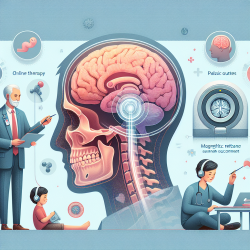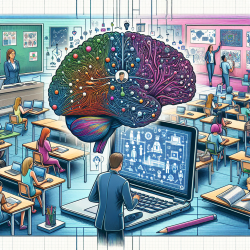Introduction
Amyotrophic lateral sclerosis (ALS) is a progressive neurodegenerative disease characterized by the degeneration of motor neurons, leading to muscle weakness and atrophy. Recent research by Ishaque et al. (2022) has provided new insights into the patterns of cerebral degeneration in ALS using advanced MRI techniques. This blog post will explore how these findings can inform and enhance the practice of speech-language pathologists, particularly those working with children in online therapy settings like TinyEYE.
Understanding the Research
The study utilized three-dimensional texture analysis on T1-weighted MRI images to examine the progression of gray and white matter degeneration in ALS patients. The research involved 137 ALS patients and 119 controls, with follow-up assessments over eight months. Key findings included:
- Baseline texture changes in ALS patients were noted in the motor cortex, corticospinal tract, insular cortex, and bilateral frontal and temporal white matter.
- Longitudinal changes showed progressive texture alterations in the temporal white matter, insula, and internal capsule.
- Distinct patterns of degeneration were observed between slow and fast-progressing ALS patients, with implications for phenotypic variability.
Implications for Speech-Language Pathologists
While ALS primarily affects adults, understanding its pathology can offer valuable insights for speech-language pathologists working with neurodegenerative conditions in children. Here are some ways the findings can be applied:
- Early Detection: The use of advanced imaging techniques, such as texture analysis, can aid in the early detection of neurodegenerative changes, allowing for timely intervention.
- Personalized Therapy: Recognizing distinct patterns of degeneration can help tailor therapy approaches to individual needs, improving outcomes for children with similar conditions.
- Interdisciplinary Collaboration: Collaborating with neurologists and radiologists can enhance understanding and treatment of neurodegenerative diseases, fostering a holistic approach to care.
Encouraging Further Research
The study highlights the importance of continuous research in understanding cerebral degeneration patterns. Speech-language pathologists are encouraged to engage in or support further research to explore:
- The application of MRI texture analysis in pediatric populations with neurodegenerative conditions.
- The development of new therapeutic strategies based on imaging findings.
- The impact of early intervention on long-term outcomes in children with neurodegenerative diseases.
Conclusion
The research by Ishaque et al. provides a deeper understanding of the cerebral degeneration patterns in ALS, offering valuable insights for speech-language pathologists. By integrating these findings into practice, practitioners can enhance their skills and improve outcomes for children in their care.
To read the original research paper, please follow this link: Distinct patterns of progressive gray and white matter degeneration in amyotrophic lateral sclerosis.










